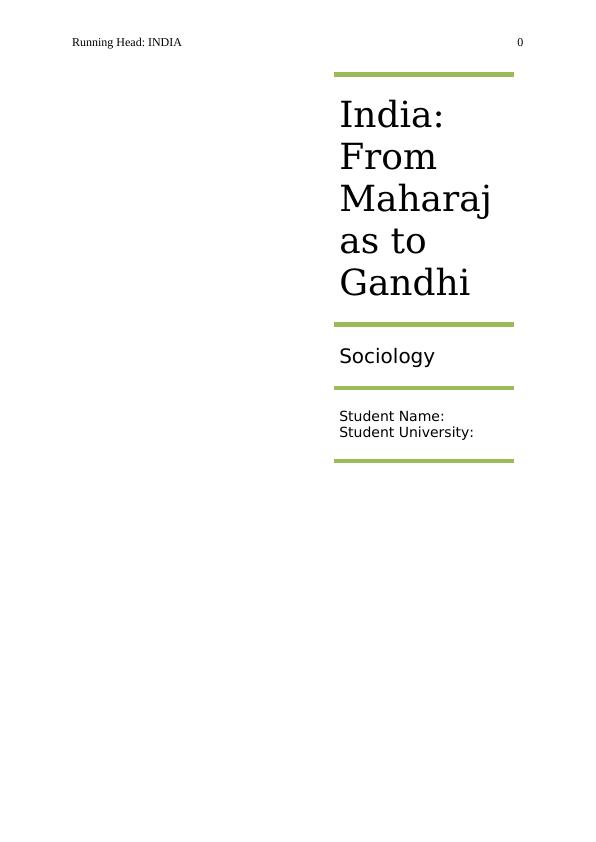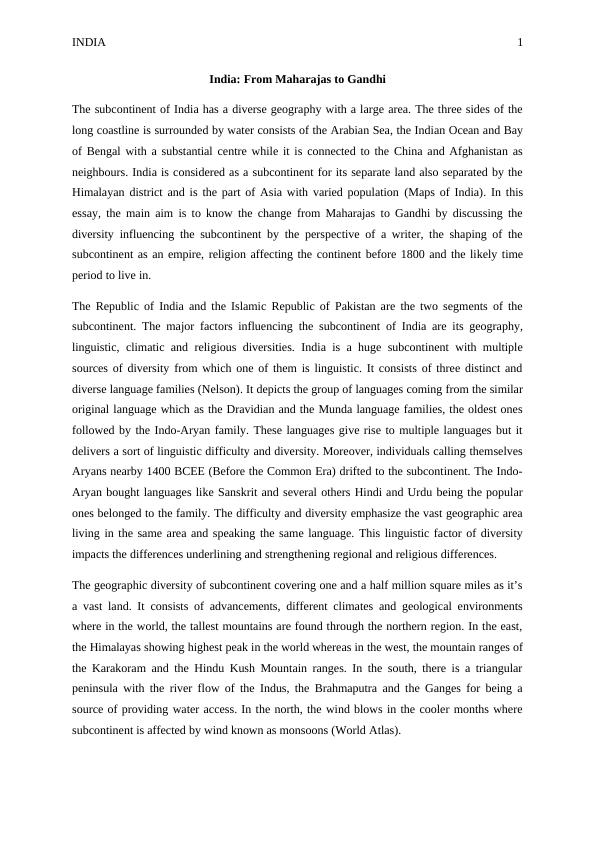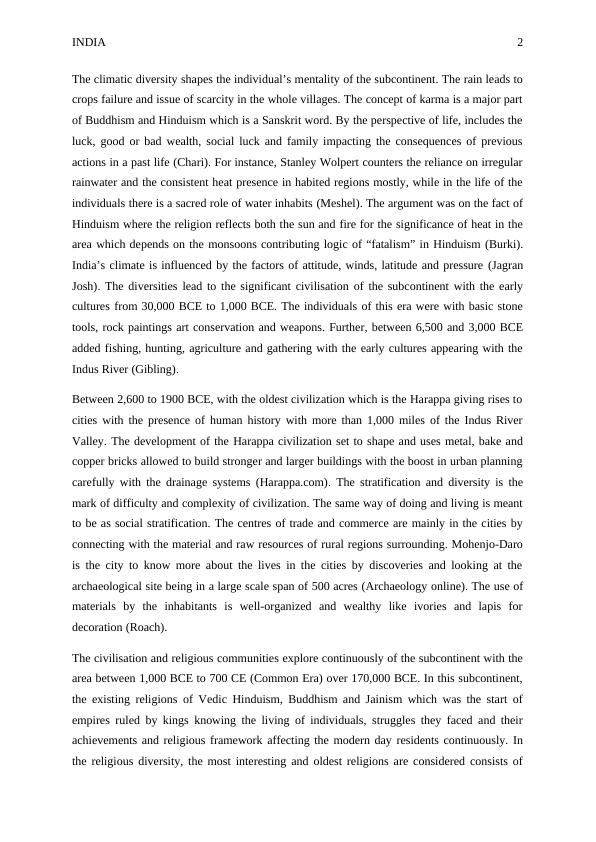The subcontinent of India has a diverse geography with a large area
Added on 2022-10-09
7 Pages1924 Words38 Views
Running Head: INDIA 0
India:
From
Maharaj
as to
Gandhi
Sociology
Student Name:
Student University:
India:
From
Maharaj
as to
Gandhi
Sociology
Student Name:
Student University:

INDIA 1
India: From Maharajas to Gandhi
The subcontinent of India has a diverse geography with a large area. The three sides of the
long coastline is surrounded by water consists of the Arabian Sea, the Indian Ocean and Bay
of Bengal with a substantial centre while it is connected to the China and Afghanistan as
neighbours. India is considered as a subcontinent for its separate land also separated by the
Himalayan district and is the part of Asia with varied population (Maps of India). In this
essay, the main aim is to know the change from Maharajas to Gandhi by discussing the
diversity influencing the subcontinent by the perspective of a writer, the shaping of the
subcontinent as an empire, religion affecting the continent before 1800 and the likely time
period to live in.
The Republic of India and the Islamic Republic of Pakistan are the two segments of the
subcontinent. The major factors influencing the subcontinent of India are its geography,
linguistic, climatic and religious diversities. India is a huge subcontinent with multiple
sources of diversity from which one of them is linguistic. It consists of three distinct and
diverse language families (Nelson). It depicts the group of languages coming from the similar
original language which as the Dravidian and the Munda language families, the oldest ones
followed by the Indo-Aryan family. These languages give rise to multiple languages but it
delivers a sort of linguistic difficulty and diversity. Moreover, individuals calling themselves
Aryans nearby 1400 BCEE (Before the Common Era) drifted to the subcontinent. The Indo-
Aryan bought languages like Sanskrit and several others Hindi and Urdu being the popular
ones belonged to the family. The difficulty and diversity emphasize the vast geographic area
living in the same area and speaking the same language. This linguistic factor of diversity
impacts the differences underlining and strengthening regional and religious differences.
The geographic diversity of subcontinent covering one and a half million square miles as it’s
a vast land. It consists of advancements, different climates and geological environments
where in the world, the tallest mountains are found through the northern region. In the east,
the Himalayas showing highest peak in the world whereas in the west, the mountain ranges of
the Karakoram and the Hindu Kush Mountain ranges. In the south, there is a triangular
peninsula with the river flow of the Indus, the Brahmaputra and the Ganges for being a
source of providing water access. In the north, the wind blows in the cooler months where
subcontinent is affected by wind known as monsoons (World Atlas).
India: From Maharajas to Gandhi
The subcontinent of India has a diverse geography with a large area. The three sides of the
long coastline is surrounded by water consists of the Arabian Sea, the Indian Ocean and Bay
of Bengal with a substantial centre while it is connected to the China and Afghanistan as
neighbours. India is considered as a subcontinent for its separate land also separated by the
Himalayan district and is the part of Asia with varied population (Maps of India). In this
essay, the main aim is to know the change from Maharajas to Gandhi by discussing the
diversity influencing the subcontinent by the perspective of a writer, the shaping of the
subcontinent as an empire, religion affecting the continent before 1800 and the likely time
period to live in.
The Republic of India and the Islamic Republic of Pakistan are the two segments of the
subcontinent. The major factors influencing the subcontinent of India are its geography,
linguistic, climatic and religious diversities. India is a huge subcontinent with multiple
sources of diversity from which one of them is linguistic. It consists of three distinct and
diverse language families (Nelson). It depicts the group of languages coming from the similar
original language which as the Dravidian and the Munda language families, the oldest ones
followed by the Indo-Aryan family. These languages give rise to multiple languages but it
delivers a sort of linguistic difficulty and diversity. Moreover, individuals calling themselves
Aryans nearby 1400 BCEE (Before the Common Era) drifted to the subcontinent. The Indo-
Aryan bought languages like Sanskrit and several others Hindi and Urdu being the popular
ones belonged to the family. The difficulty and diversity emphasize the vast geographic area
living in the same area and speaking the same language. This linguistic factor of diversity
impacts the differences underlining and strengthening regional and religious differences.
The geographic diversity of subcontinent covering one and a half million square miles as it’s
a vast land. It consists of advancements, different climates and geological environments
where in the world, the tallest mountains are found through the northern region. In the east,
the Himalayas showing highest peak in the world whereas in the west, the mountain ranges of
the Karakoram and the Hindu Kush Mountain ranges. In the south, there is a triangular
peninsula with the river flow of the Indus, the Brahmaputra and the Ganges for being a
source of providing water access. In the north, the wind blows in the cooler months where
subcontinent is affected by wind known as monsoons (World Atlas).

INDIA 2
The climatic diversity shapes the individual’s mentality of the subcontinent. The rain leads to
crops failure and issue of scarcity in the whole villages. The concept of karma is a major part
of Buddhism and Hinduism which is a Sanskrit word. By the perspective of life, includes the
luck, good or bad wealth, social luck and family impacting the consequences of previous
actions in a past life (Chari). For instance, Stanley Wolpert counters the reliance on irregular
rainwater and the consistent heat presence in habited regions mostly, while in the life of the
individuals there is a sacred role of water inhabits (Meshel). The argument was on the fact of
Hinduism where the religion reflects both the sun and fire for the significance of heat in the
area which depends on the monsoons contributing logic of “fatalism” in Hinduism (Burki).
India’s climate is influenced by the factors of attitude, winds, latitude and pressure (Jagran
Josh). The diversities lead to the significant civilisation of the subcontinent with the early
cultures from 30,000 BCE to 1,000 BCE. The individuals of this era were with basic stone
tools, rock paintings art conservation and weapons. Further, between 6,500 and 3,000 BCE
added fishing, hunting, agriculture and gathering with the early cultures appearing with the
Indus River (Gibling).
Between 2,600 to 1900 BCE, with the oldest civilization which is the Harappa giving rises to
cities with the presence of human history with more than 1,000 miles of the Indus River
Valley. The development of the Harappa civilization set to shape and uses metal, bake and
copper bricks allowed to build stronger and larger buildings with the boost in urban planning
carefully with the drainage systems (Harappa.com). The stratification and diversity is the
mark of difficulty and complexity of civilization. The same way of doing and living is meant
to be as social stratification. The centres of trade and commerce are mainly in the cities by
connecting with the material and raw resources of rural regions surrounding. Mohenjo-Daro
is the city to know more about the lives in the cities by discoveries and looking at the
archaeological site being in a large scale span of 500 acres (Archaeology online). The use of
materials by the inhabitants is well-organized and wealthy like ivories and lapis for
decoration (Roach).
The civilisation and religious communities explore continuously of the subcontinent with the
area between 1,000 BCE to 700 CE (Common Era) over 170,000 BCE. In this subcontinent,
the existing religions of Vedic Hinduism, Buddhism and Jainism which was the start of
empires ruled by kings knowing the living of individuals, struggles they faced and their
achievements and religious framework affecting the modern day residents continuously. In
the religious diversity, the most interesting and oldest religions are considered consists of
The climatic diversity shapes the individual’s mentality of the subcontinent. The rain leads to
crops failure and issue of scarcity in the whole villages. The concept of karma is a major part
of Buddhism and Hinduism which is a Sanskrit word. By the perspective of life, includes the
luck, good or bad wealth, social luck and family impacting the consequences of previous
actions in a past life (Chari). For instance, Stanley Wolpert counters the reliance on irregular
rainwater and the consistent heat presence in habited regions mostly, while in the life of the
individuals there is a sacred role of water inhabits (Meshel). The argument was on the fact of
Hinduism where the religion reflects both the sun and fire for the significance of heat in the
area which depends on the monsoons contributing logic of “fatalism” in Hinduism (Burki).
India’s climate is influenced by the factors of attitude, winds, latitude and pressure (Jagran
Josh). The diversities lead to the significant civilisation of the subcontinent with the early
cultures from 30,000 BCE to 1,000 BCE. The individuals of this era were with basic stone
tools, rock paintings art conservation and weapons. Further, between 6,500 and 3,000 BCE
added fishing, hunting, agriculture and gathering with the early cultures appearing with the
Indus River (Gibling).
Between 2,600 to 1900 BCE, with the oldest civilization which is the Harappa giving rises to
cities with the presence of human history with more than 1,000 miles of the Indus River
Valley. The development of the Harappa civilization set to shape and uses metal, bake and
copper bricks allowed to build stronger and larger buildings with the boost in urban planning
carefully with the drainage systems (Harappa.com). The stratification and diversity is the
mark of difficulty and complexity of civilization. The same way of doing and living is meant
to be as social stratification. The centres of trade and commerce are mainly in the cities by
connecting with the material and raw resources of rural regions surrounding. Mohenjo-Daro
is the city to know more about the lives in the cities by discoveries and looking at the
archaeological site being in a large scale span of 500 acres (Archaeology online). The use of
materials by the inhabitants is well-organized and wealthy like ivories and lapis for
decoration (Roach).
The civilisation and religious communities explore continuously of the subcontinent with the
area between 1,000 BCE to 700 CE (Common Era) over 170,000 BCE. In this subcontinent,
the existing religions of Vedic Hinduism, Buddhism and Jainism which was the start of
empires ruled by kings knowing the living of individuals, struggles they faced and their
achievements and religious framework affecting the modern day residents continuously. In
the religious diversity, the most interesting and oldest religions are considered consists of

End of preview
Want to access all the pages? Upload your documents or become a member.
